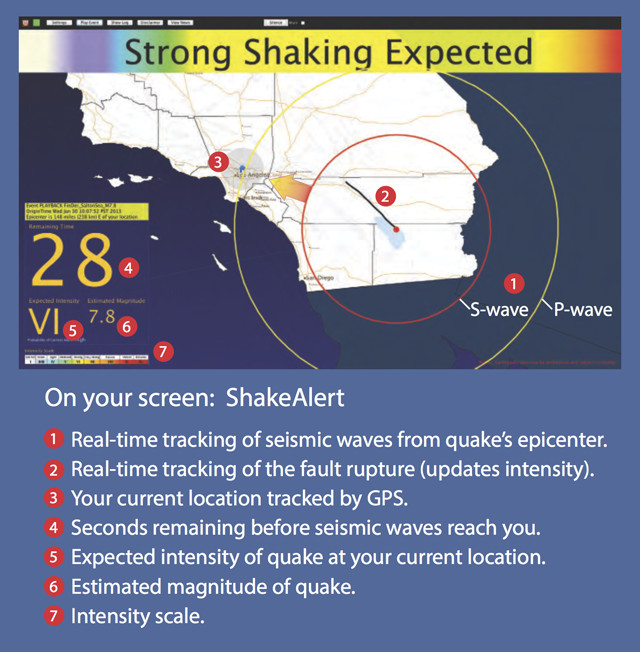
by Mary Caperton Morton Thursday, January 19, 2017

Example of early warning issued by ShakeAlert. Credit: Public Domain.
Can seismologists tell from the first few seconds of recorded seismic data how big an earthquake is going to be, or does it take longer and require data that come in after a quake rupture has progressed along the fault? The answer to this question underpins the usefulness of earthquake early warning systems and has perplexed scientists for decades. In a new study, researchers looking at near-source seismic recordings from shallow crustal earthquakes have found that, within the first few seconds of rupture, large and small earthquakes appear indistinguishable from one another, hinting that initial rupture behavior may be universal among variously sized events.
The concept of earthquake early warning systems was first proposed in the 19th century, but the technology to track real-time observations and predict shaking severity only came about in the early 2000s. In recent years, a number of researchers subscribing to the “deterministic” model of earthquake behavior “have claimed they can tell in the first few seconds if [an event] is going to be a big or a small earthquake,” says Men-Andrin Meier, a geophysicist at Caltech and lead author of the new study, published in Geophysical Research Letters. “But their data tend to be thin, and the theory goes against some basic concepts of earthquake rupture physics,” he says, such as the chaotic effects on rupture patterns caused by the variety of rocks that can be present along a single fault line.
Crucial clues are found in careful analysis of the first few seconds of earthquake rupture behavior, Meier says. In deterministic models, large and small quakes display different patterns of behavior from the onset of rupture, enabling seismologists to distinguish large and small quakes in the first few seconds of rupture. In “cascade” models, the sort that Meier and his colleagues investigate, the quakes’ eventual size is determined as the rupture progresses — over seconds to minutes — by the physical characteristics of the fault and by the stress field that the ongoing rupture encounters, rather than by what happens right at the onset.
Studying the fine details of rupture onset behavior is best achieved using seismic recordings that were made at short distance from the epicenter, Meier says. “When you look at a [non-near-source] seismogram, you don’t just see what’s happening on the fault that ruptured, you’re also seeing everything that happens along the path that the waves travel from the fault to the seismic station,” he says, which can complicate interpretation of seismic data. “If you only look at short-distance recordings, this noise effect from the path is much smaller in the seismogram, and it makes it easier to see the initial nuances of rupture behavior.”
Meier’s team therefore looked only at recordings made by instruments within 25 kilometers of an earthquake’s epicenter for more than 3,000 shallow crustal events with magnitudes between 4 and 8 that occurred in California and Asia between 1990 and 2015. They found that the small and large events were statistically indistinguishable from each other in the first few seconds of rupture. “We cannot tell them apart in any meaningful way,” Meier says. The team focused on that magnitude range because quakes under magnitude 4 are usually recorded by different types of instruments and near-source recordings are rare for larger quakes, which usually occur offshore along subduction zones.
“I don’t know if [this study] settles the debate but it certainly is a nail in the coffin for the deterministic model,” says Diego Melgar, a seismologist at the University of California Berkeley Seismological Laboratory who was not involved in the new study. “They went through a huge amount of near-source data very methodically and their findings are very compelling.”
The next step in addressing, and possibly ending, the deterministic-versus-cascade debate is to go offshore and install instruments to closely study the largest quakes, Melgar says. “To get near-source recordings of subduction zone quakes, you need to install instruments on the seafloor. That kind of dataset would really settle it.” Unfortunately, installing instruments on the seafloor is difficult, dangerous and costly. “That’s the next frontier in geophysics,” Melgar says.
In the meantime, Meier’s team’s study has implications for earthquake early warning systems, such as ShakeAlert, which is being developed by the U.S. Geological Survey (USGS) and partners for the west coast of North America. Currently, the system is aiming to give people five to 10 seconds of warning between the detection of the initial P-wave and the arrival of the more damaging S-wave. “Our findings somewhat shorten the potential warning times such systems can provide,” Meier says, because they imply that it takes longer for the size of an earthquake to be determined. “But useful warnings are still possible.”
In February 2016, USGS rolled out a production prototype of the ShakeAlert system in California to select testers, with plans to bring the system to the public in the next few years. “These findings temper our expectation of what earthquake early warning systems can provide,” says Melgar, who is involved with ShakeAlert. “It doesn’t mean the systems won’t work, it just makes us think more deeply about the problem we’re trying to solve.”
© 2008-2021. All rights reserved. Any copying, redistribution or retransmission of any of the contents of this service without the expressed written permission of the American Geosciences Institute is expressly prohibited. Click here for all copyright requests.